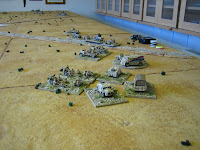
The Ilkley Lads will be doing Bir El Gubi 1941 at Vapnartak this year (York Race Course, 6th February). This was the first major clash of Operation Crusader, between British 22nd Armoured Brigade Group and Ariete Armoured Division, on the southern flank of the Axis investment of Tobruk. The game will use Mark D's Italian stuff and my British stuff. I still have a few things to finish off (some mine fields - one down three to go, and 10 Italian medium tanks - which I'll knock off this weekend) but we had enough to have a run through last night. Here are some picks of of the game half way through.


The tanks of 22nd Armoured Brigade attacking from the south (possibly south east) break into Bir El Gubi's defences. They are being funneled by minefields and they are becoming 'horribly bunched'. We are using Piquet rules (heavily amended) which allows for all manner of 'randomisation'. Reading about the battle, one thing I noticed was the repeated line 'ran into minefields'; Consequently, I have given the Italians four minefields that they can place during the game when they turn a 'special card' - they have three in their deck. They can place them anywhere they want, if they want, providing no troops are 'in the minefield' when it is placed. This worked well.


The Battle of Bir El Gubi involved the arrival of reinforcements for both sides. A CLY Regiment (Crusaders) arrives on turn 2 moving to find the northern flank of of the Italians, and the artillery and infantry support for 22nd Armoured Brigade Group arrives at the same time in the wake of the major thrust from the south. On turn 3 the first battalion of 132nd Regt (M13s) arrives for the Italians - they will bump into the newly arrived CLY Regt. Another battalion of M13s arrives on turn 5. Arrivals are timed by turn and the turning of 'stratagem cards'.
The general terrain layout was derived from books and, more usefully, Google Earth. Looking at Google Earth is very useful for getting Western Desert terrain right - unlike a scenario in an otherwise very useful wargames tome - it appears that there are no escarpments or 'hills' at Bir El Gubi. The terrain will not win any prizes, but it will show 'punters' the general flatness and empty waste that is the Western Desert - too frequently 'WW2 desert games' have far too much terrain. BTW, according to Robert Crisp (in his memoir 'Brazen Chariots'), Bir El Gubi was a single white building surrounded by a low parapet - there are two buildings there now!
Main sources, were: The Sidi Rezeg Battles 1941, Iron Hulls Iron Hearts, Crusader, Operation Crusader 1941 and Benghazi Handicap. (For authors, etc, these books are listed in this blogs 'labels' side bar.)
Figures are by various manufacturers including FoW and Skytrex. Painting by Mark D. and myself.
Figures are by various manufacturers including FoW and Skytrex. Painting by Mark D. and myself.
7 comments:
Lovely - just lovely... and the best thing about it is that it looks like I imagine a North Africa battle would have been - wide open spaces with small pockets of activity...
Great looking battle. How big is the table?
Hi Victor,
Thanks. 12 x 6
Looks great! I've fought similar in 6mm but it looks better in 15.
That is, indeed, a lovely, big table. I wish I could fit one in...
Looks good James! Very ably demonstrates how attractive simple setups can be. I've admired your desert terrain boards for some time.
What materials are used to make those modular sections? I also noticed what look like custom cards on the table. Nice touch. Great looking table all around.
Hi Ron,
Thanks.
The basic terrain tiles, 2 foot x 2 foot, are my green flocked polystyrene tiles by TSS / PMC - I turned them upside down and painted the white side, in emulsion paint, with a three highlight big brush stipple technique. It saves a lot on storage space, the table-top itself is painted blue for sea.
Should be at the York show, and look forward to seeing the game.
Post a Comment